Another ocean racing weekend completed, this time in Wrightsville Beach, NC at the Carolina Cup. I raced in the surfski class this time, as opposed to OC2 and OC6 last weekend at the Shark Bite Challenge in FL. I definitely set myself up for a bigger challenge. I raced in my new Nelo Kayaks 550ML in Saturday’s Money Island 10K race and in Sunday’s Graveyard 13 mile challenge. Last year I raced in the Graveyard in a borrowed Nelo 520 (from EliteOceanSports, LLC) and all paddlers raced on one day – with hundreds of paddle craft.
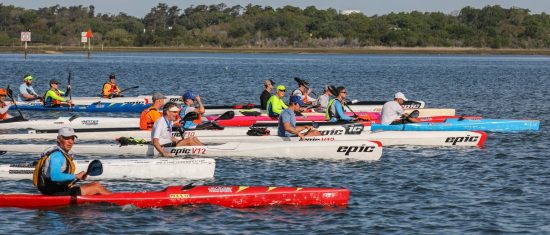
Just wanted to share some of my experiences from the weekend and most important, lessons learned.
While my results may not look as good as expected, I paddled as strong and as efficiently as I could both days and survived more of the ocean in a tippier boat than ever before without panicking (more on that later).
Thank you again to the team at EliteOceanSports, LLC (EOS), Jupiter Surfski the EOS “family” of paddlers/supporters and Oscar ChalupskyOscar Chalupsky Paddler for making this a really amazing weekend overall and taking care/supporting so many people. A lot of learning packed into one weekend, reconnecting with friends and meeting many new ones. (and thanks for the fixes to my new boat on Friday!).
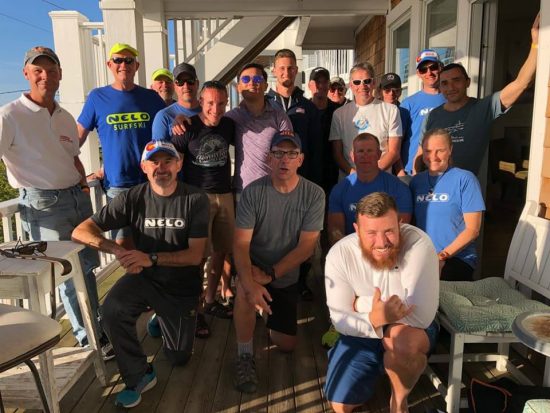
Familiar faces. Cliff, Oscar, Braxton, Jesse,Eric,Rowan, Mark, Michael, Vadim, Mike, Mark, Pam and others.
Thanks to all of the volunteers who made the Carolina Cup happen, including local law enforcement, fire/rescue, and the Coast Guard. A ton of races and incredible logistics and patient/hard-working volunteers to make everything happen.
This year, there were 2 days of racing: Saturday was the SUP Graveyard plus the 10K and 5K races for any craft. The Sunday Graveyard was only for surfskis and outrigger canoes. There were only about 55 or so boats on Sunday. The start and finish were on the protected inter-coastal waterway (ICW) side, with a water start and a beach finish. The SUP Graveyard on Saturday had a huge field and the race was televised/highly sponsored race. It started and finished on the ocean side (beach start/finish). That definitely had more room for spectators. ’m not sure why the race format was completely different – perhaps the beach conditions were worse on Sunday ? — but race organizers did change the direction of the Sunday race to ensure we weren’t plowing into a side-headwind for the 6 mile ocean segment.
I started out my weekend with Oscar Chalupsky’s Surfski Clinic. That was a smart decision as it was primarily focused on the basics of technique and feel, and trying to understand more about how my body/paddle should move with the boat no matter the conditions. Also learned a bit more about equipment and why/how they’ve evolved over the years. I needed a technique-focused day with individual feedback more than anything and that carried me through the weekend, particularly the very challenging Graveyard race on Sunday.
I needed to get back in touch with my body positioning, greater awareness of right/left differences, my elbow(s) position, shoulders, hands, paddle (length/twist), legs, feet, how I was holding the paddle and entering the water, and getting more insight into what my reference points should be for connecting the dots for an efficient/powerful stroke on each side. Oscar also showed us how to properly get into (and *back into*) our surfski, and get comfortable with feet out to the side and using sweep strokes to move our legs into or over the boat to the other side – just hammering in how this should feel/work after remounts. I got to practice my remount in my new boat near the end of the clinic without a bulky PFD. I had only paddled the boat 2 times at home because the water had been too cold to stomach remounts.
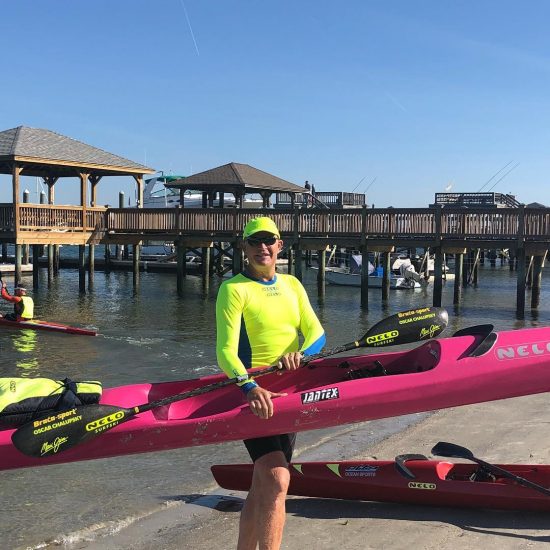
Oscar takes 4th at Money Island Race, shoulder recovery going well.
The most important stroke he had us get reacquainted with was “the brace”. My right brace has always not been very good and my right side generally has always been much less confident/powerful as I tend to lean to the left to favor the better bracing side. We talked about blade angle and I had been paddling at a 60 degree angle since last year (using my Jantex paddle). Friday during the clinic, I switched to 40 and even played with it at 30. I also lengthened the paddle for the drills and played with it at a much longer length than the 209 I’d been using.
I started to feel a better brace, and putting more weight on the paddle helped alter how I was feeling catching on the right side. I finally settled on 209 ¾ length for the races (not a huge change but enough to make a difference) and kept it at a 40 angle. I also noticed during the clinic that I wasn’t quite entering the water correctly on either side with the blade – it wasn’t angled properly. Not way off, but enough for me to feel a difference. I started to make some connections I hadn’t made before. I knew I needed this clinic to go into the weekend racing with a little more confidence, particularly with my right side, knowing the conditions could be rougher than I’m used to. I put as much of it as possible to use, unfortunately some things more than others.
The Saturday Money Island race (which raced in the opposite direction of the event photo) had an exciting lineup of surfskis, outrigger canoes, and SUPs all on the line at the same time. 62 women in all – but only 3 women in surfskis – Kelly Rhodes (my marathon canoe/outrigger canoe partner who also races sprint kayaks), Kata Ludanyi Dismukes and me. The rest were on SUPs. I let Kelly use my Think Evo II while I raced in my new Nelo. Crosswind made lining up a joy. I was getting tossed around a bit with bumper boats/SUP boards on the left side of the start line so went with a group over to the right side, even though the course had us turning left down the way. Less wind on the right made lining up for everyone in that area there a little smoother, but I lost contact with Kelly and Kata for the start.
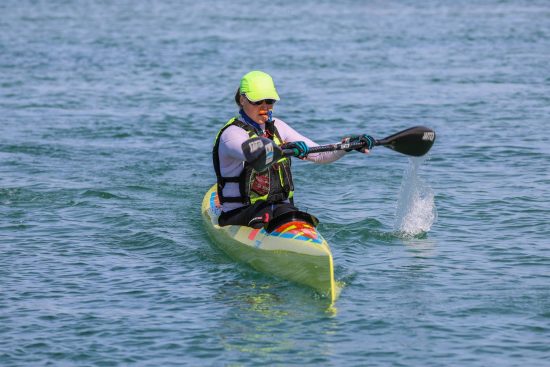
Pam in good form takes 2nd place in Money Island Race
There were no drafting rules in effect so it was a free for all and you could ride anyone. I had to fight my way up and over to reconnect with them, but didn’t have the spunk that day to bridge the gap with Kelly. I needed a burst to connect with them early in the race and just didn’t have it. Kelly and Kata were together just ahead of me for quite a while before Kelly surged ahead and broke away, staying connected with some male surfski paddlers. I caught up to Kata and we stayed together for a while. I don’t remember when we disconnected, but I was focused on bridging the gap with Kelly for the last few miles. I made up some ground going around the last left turn and crossed the big channel early to get out of the wind. I saw others had stayed left and middle much longer so thought I could gain some advantage. It certainly was better to the right, but I didn’t gain enough. I finished just behind her, with Kata in 3rd. It was great to have a full podium for women’s surfski for the first time at the CC.
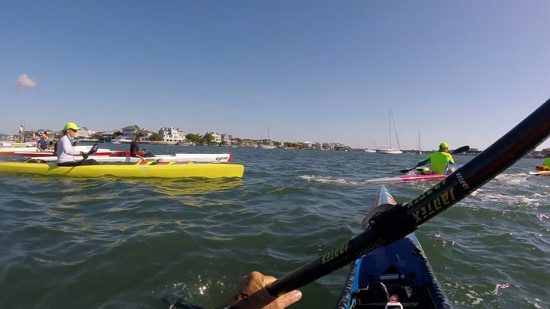
Pam in Yellow ski, Oscar in Pink.
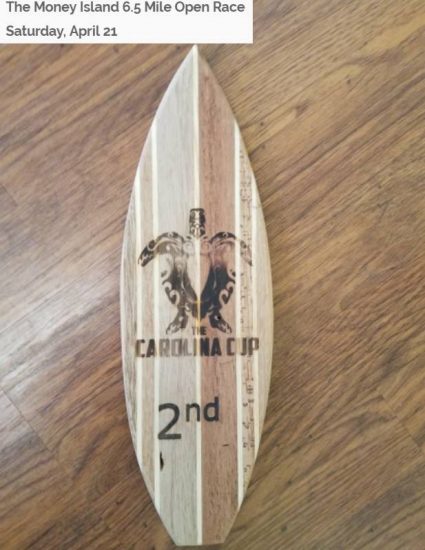
Pam takes 2nd Place in Money Island Race

For the Graveyard race on Sunday – my result was unfortunately DNF (did not finish). I took a chance this year and committed to racing my new Nelo 550ML, but for this race – for the ocean conditions – I really needed to be in a 520. I felt much stronger on Sunday physically on the water (must have been my long nap on Saturday!). I had a good start and was able to settle into a good pace early. And for the first time in a few weeks, my HR was not running out of control. (It, and my resting HR, was jacked at Shark Bite last weekend, which was a sign of under-recovering). I was able to settle at about 155 and keep it there for the first 6 or so miles. Kata and I were together for the first 3 or so miles in the ICW. I knew I had to get a lead on her as she has more experience in rougher water, so picked up the pace a bit to get a bit of a gap going into the ocean segment. There were drafting rules in effect (draft only your class and gender) so we were on our own.
Luckily there were people ahead of and around me to follow into the ocean. We had to go out to a huge orange buoy to make a right turn and set us on our course south. While some people said before the race it was “mild conditions” out in the ocean, it was *not* mild in my book. The wind was an east/northeast wind, which meant from the left side going down the course and quartering (like from 8 o’clock) with swells which got bigger/sharper the closer in to shore you got. I expected rougher conditions than I am used to, but not this – what felt like confused mangled water/swells.
I was astonishingly able to stay calm and follow others in front of me. This in and of itself was a miracle since I have a too-long history of anxiety attacks, or anxiety in general, in rough water, and oceans are just another world. I knew I had to stay out further as I watched the paddlers ahead stay out farther. It seemed the waves got sharper and seemed to get bigger/stronger closer in (which still wasn’t *that* close to shore).

Start of Graveyard Race on Sunday. Eric Costanza in V12
I had Friday’s clinic in my mind the entire time. I had to paddle the same as I would paddle in flat water and definitely keep my elbows low and catches firm and consistent. I used my left AND right brace when I needed and tried to focus on the drills. (hint – they work). Just keeping a steady pace to keep the boat moving was my goal at this stage. I knew a stopped boat was a dead boat.
But then one weird wave knocked me in on the left (my “good” brace) side. I flipped and got a tangled in my leash and drink tube but I was able to remount surprisingly well after angling my boat better to not get hit from the side. This was a BIG accomplishment in this water. I kept going for a bit longer then another weird wave hit. I went in again on the left and was tangled even more. I was taking longer to get in this time and my foot brace had twisted backwards some, which was making it difficult to get my feet back in to steer. Kata was coming up on me and asked me if I was OK. (thank you Kata!). My foot brace had twisted around so the curved side was in – which meant I could not slide my feet under it to get to the pedals. A little disconcerting as I had to poke a pedal from the top with a foot just to point the boat in the right direction so I could get the strap twisted back. I wanted to see my Garmin (which was attached to it) so I could see my distance to have some idea of how far along I was (or wasn’t). Kata and I stayed together for just a little bit longer and I was hoping this would last for the entire ocean stretch, but it wasn’t to be. I dunked again – on the right. Now I got to try my right side mount. But, I was still surprisingly calm. I went through my mental checklist again, got myself untangled, pointed my boat how I wanted it, waited for a swell to come to help lift me up, and got back in. I just wanted to make it through and finish at this point.
Every time I flipped and it took me longer to get back in, I’d get pushed closer to shore, where I did not want to go. I was still far from shore, but I didn’t want to go that direction. Also, each successive time I flipped, my foot brace was turning. Finally I figured out that I needed to adjust that before getting back into the boat. My remounts were generally pretty good and I was oddly – calm (though admittedly frustrated). My @Mocke leash was working brilliantly and my paddle string was staying connected to me. At least 2 of the remounts, I fell back in and had to start over again as I didn’t get my butt all the way into the seat bucket. I needed to get my body more over the ski, rest/relax for a minute, and then turn my butt in. The longer I took to get going again, the more alone I became.
I made it about 4 miles into the ocean stretch (as you can see from the Garmin map), but after too many more flips (about 8 by this stage) and getting completely disconnected from anyone, and given there was no safety boat in sight, I decided to head to shore and stop. ….
I didn’t want to DNF and the thought pained me. I always want to be known for not giving up, no matter what. But I had I think another mile and a half to go before the jetty turn at Masonboro Inlet. I could see the long land mass ahead of me but I knew from last year that it was very rough around the turn (though last year we were coming out of this jetty). Given the conditions felt rougher than last year, going through the jetty alone was just dangerous for me. I had already stretched my skill set in this boat.
Now I just needed to get to shore. As I got closer I could feel the power of the waves even more from my back. I did not know I had a lot of water in my boat, but now I know why my nose was diving in more than it should have. That made “surfing” in – ugly. I got spun out twice. I remounted both times, then got tossed again. This time my paddle string snapped where it was tied to the paddle but my leash was still connected to the boat. I had already unleashed but was able to grab the string as I didn’t want the boat to fly away just yet. I ensured my boat was in front of me at this point (lesson learned from previous ocean trips). Another wave came through closer to shore (in about 6 ½ feet of water here) and I just let it take my boat into the soft beach with a nice tumble. I was not going to stay connected to that.
I waved down some beach cyclists. They waved and smiled back thinking I was saying hello. They finally figured out I was not saying hello but sort of asking for assistance. I asked them about the jetty down the way and how far down it was. They were surprised I was out in the ocean at all and said it would only be rougher closer to and around the jetty. I opted to officially bail. About 5 minutes later a beach rescue truck was driving by on normal patrol. I flagged him down and told him I was racing and had pulled out. He radioed in to tell race organizers I was out and called to get someone to come get me. Turns out I was just down the road from the Blockade Hotel.
I sat on the beach for what I guess was 15 minutes. Was getting a little chilled by this point and it was not my happiest moment as I really wanted to finish….. The guy who came and got me was really nice and paddles OC with the Wrightsville Beach Club. As he was carrying my ski he said there was a ton of water in it. I figured I’d get that figured out once I got it back to the EOS house.
Once back at the house – Oscar saw me from across the street. He didn’t have to do this, but he stopped his conversation and asked me how the race went. I hesitated but said I pulled out, then asked for his help with the boat. He did NOT have to help me and stop what he was doing, but he came right over and drained the boat for me and told me to just go get into some warm clothes and get settled. I asked him where the water came in and he showed me the tiny drain hole in the front top of the foot-well. So, each flip, I took on more water. That explained the nose diving trying to get into the shore (I presume).
At the end of the day – I have no regrets in my decision. Disappointment, yes. But it was the right call.
I’m actually happy and relieved that I never “panicked”, even though remounting and getting going again was getting more tiring. I’ve worked very hard over the years on mindfulness/meditation techniques to help manage my anxiety and even though on land I may seem like an ADD forgetful goof, I tried to stay in the moment out in the ocean, and for the entire race. Just wasn’t the result I wanted for either day.
Observations/Lessons learned:
• Please wear your pfd and wear a leash. I love my Mocke Paddling leash and Vaikobi pfd (about 4 inches slimmer than the Mocke). The pfd is not only for buoyancy, but provides warmth (that could be good or bad).
• Leashes – I’d rather have a leash that does not have a joint for disconnecting it – like the “quick release”. I now wish they were all one piece and you just use the velcro. Out in the ocean, I don’t think you’d want a leash that would have a vulnerable joint. Sunday WAS mild compared to Hawaii so I can’t imagine the force of those waves. My leash was a lifesaver yesterday.
• Consider a leash (or string) for your paddle – attach either to your pfd or to the boat. I have mine attached to me and that has worked well for me in case I blank and accidentally let go of the paddle (which I know you’re not supposed to do).
• Practice your remounts. Both sides. It matters.
• Practice your drills. You’ll need them when you’re tired.
• Nelo 550 Foot plate “strap” – ensure the foot strap (it’s hard on mine) is tightened so it doesn’t swivel. It has a nice little mount plate so you can strap your watch on over it, which is nice. But you’ll need to tighten screws on the side to make it stay in place. This ensures that if you get tossed around with your boat, your foot brace is ready for you to get back in. This was the most disconcerting part of my remounts as it was unexpected and another thing to sort out while trying to get going again.
• Foot plate – EOS suggested removing the little studs/screws in the back and just putting some rubber on the bottom of the foot well and letting the footboard lock into that instead of the studs (which feel unsturdy and when those little rubber studs wear out all you’ll have is screws back there). Getting the pins to connect in the holes along the rails might be difficult if your foot strap is too tight or the system not aligned. Check out Oscar’s video on the adjustable foot plate https://fastpaddler.com/…/nelo-surfski-adjusting-the-foot-…/. The allen wrench included in the back is a nice touch.
• Foot pedals – consider what kind of water you will be in to determine how much you want the pedals toward or away from you. For the 10K, I think I had them too much in toward me as I would inadvertently touch the pedals and I had too much twitch. With the ocean rudder on, it definitely had me “twitchy” unnecessarily which causes drag with a big rudder. That’s my error. I’ll adjust next time. For the ocean, that setting was perfect as I wanted the pedals/rudder to move when I wanted them to move.
• Rudder – ocean rudder is great and with the pedals just right – very responsive, which is comforting in rough water. For the 10K I should have put the medium rudder on but I didn’t feel like switching things in/out.#tootired
• Seat well – it’s a tight fit. Keep this in mind when trying boats. But I was not “swimming” in my seat, which would have been catastrophic in bigger water.
• That little hole in the front of the foot well – do not cover it. After Oscar told me this was where the water was coming in, I asked if I could cover it. He said absolutely No. (the boat will pop from trapped air). Ideally – you don’t flip in races as much as I did Sunday. I’ll need to explore this a little more as I’m sure I’ll be practicing remounts in the future. I don’t want to take on water and have that affect my ability to control it in waves or simply weighing down the boat. You won’t be able to drain it unless you turn it upside down in the air to let it drain. (that won’t happen in a race or training session away from land).
• Bailer – the bailer system needs an overhaul and they know it. It’s a poor design and mine came with the little piece of neoprene installed incorrectly (as discovered by Mark McKenzie), which resulted in it leaking once it was put in the water with the bailer closed. Mark graciously spent Friday afternoon taking the bailer apart and out, putting new neoprene in it, and replacing it with the other bailer option, which I didn’t know about until he pulled it out of his magic bag. The one on the right at this link I recommend http://fastpaddler.com/…/up…/2017/03/Nelo-DeBrito-Bailer.png It’s more ergonomically fitting for the heel to open/close easily, quickly, and painlessly. The other option – I don’t understand why it is an option. The neoprene piece is key though – properly placed and the right thickness. Once that’s set the design works as it should.
• The 550ML is a great perky boat – really nice hull and is very responsive especially with the ocean rudder. It was too tippy for me once I got into the rougher/side wind and swell/inconsistent swell but it had great glide in the flatter water and I didn’t feel compromised going up against the longer boats, though I was wondering if I would have been faster in my Evo II which had the smaller profile rudder on it. (I guess I’ll have to time trial). I felt like I could apply more power and the boat would accelerate as I wanted it to. Remounting was a lot easier than with my Think Evo II since it has lower sides and a flatter hull. You do get a bit more wet in the 550 but I didn’t mind. The bailer bails quickly once you get moving. The boat is about 2 feet 5 inches shorter than my Evo II and slightly narrower. I love the narrower catch area, too.
Lastly – while it is a bit embarrassing to DNF and have to tell people that when they ask “how’d you’re race go?” I don’t regret my decision. And I don’t regret challenging myself. I’m grateful that I got to shore safely with everything intact and I’m ready to try again. I actually want to visit Wrightsville Beach and paddle with locals there to help me better understand the water and those inlets. And I’ll be sure to bring my surfski and OC1.
Congrats to Kata on her strong finish! And congrats to the 5 female OC1 paddlers and Kelly Rhodes in OC2. We were 7 women in a sea of men. Let’s keep supporting each other so we can increase our numbers each race. There are boat manufacturers like Nelo and dealers/reps like the EOS Team ready to help you get into a boat and other equipment that’s right for you.
And big congrats to fellow Surfski Clinic mate Scott Thomas, who was paddling in his Epic V5 I think. He changed his paddle twist down to 0 at Oscar’s suggestion and the drills from Friday set him up to FINISH the Graveyard, his first ocean race. Big smile on his face as Oscar asked him how he did. That – was – awesome.
Now back to the marathon canoe with Kelly to continue preparation for the General Clinton 70 miler May 28. But first, the Little d on the Monocacy 20 miler this Saturday in Frederick, MD. …
(Elite Ocean Sports) team Mark McKenzie Mark T. Smith Michael Canfield Brenda Lynn Canfield Vadim Lishchuk)
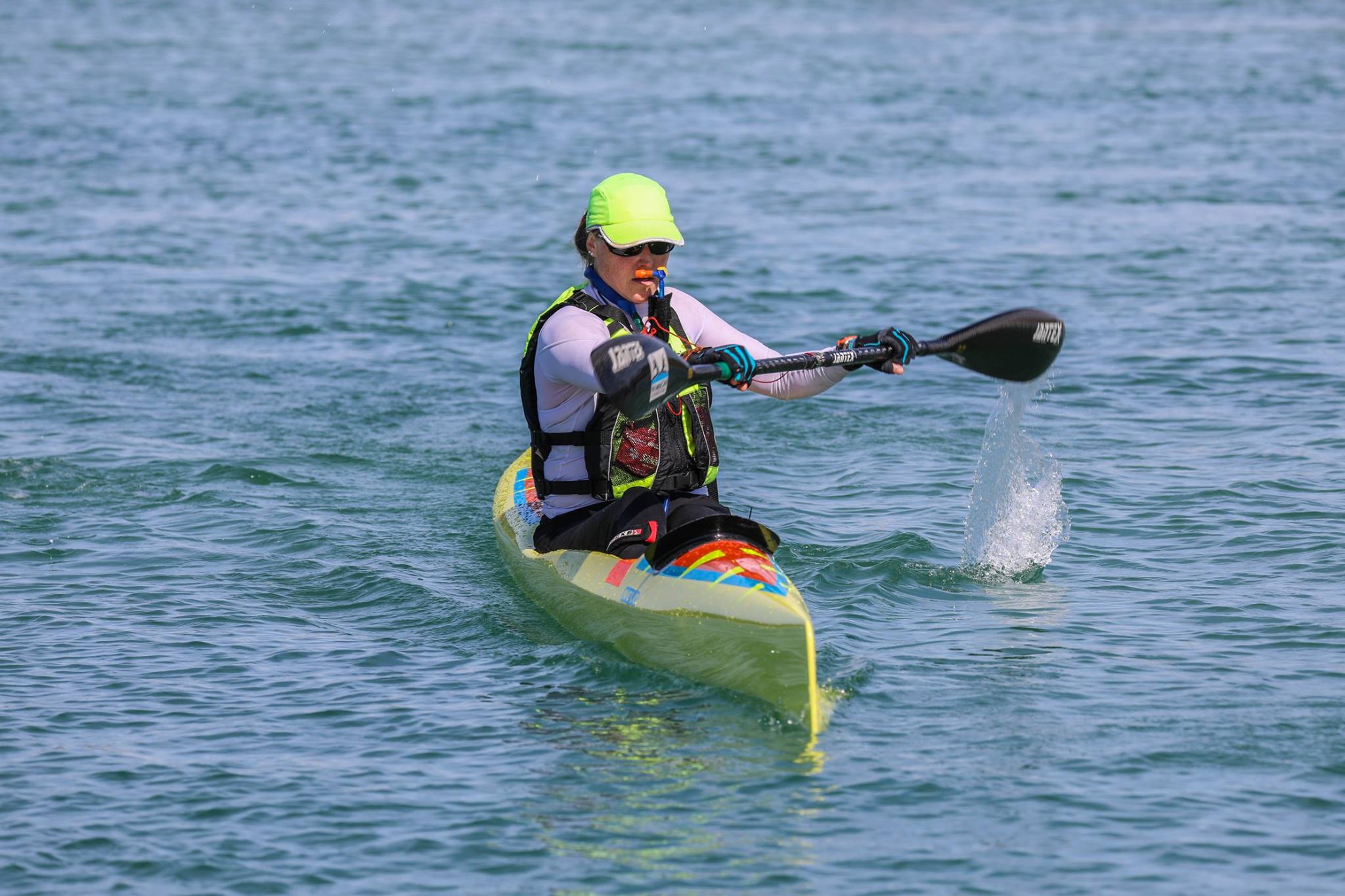
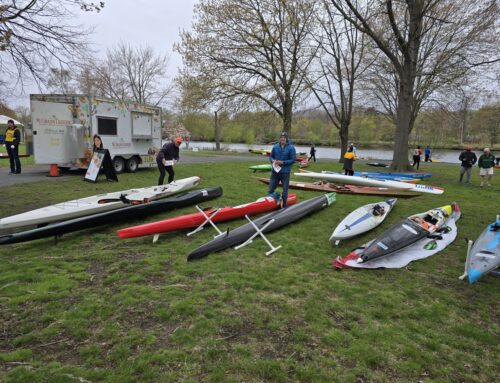
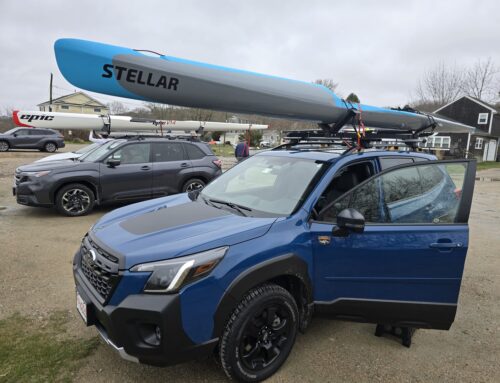
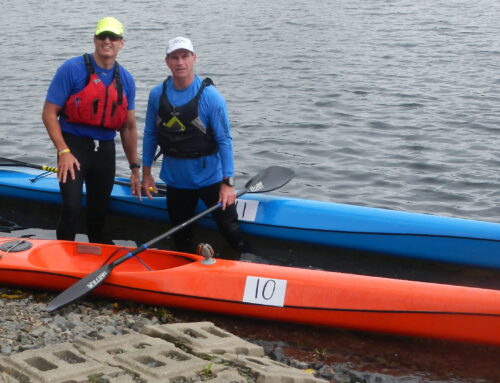
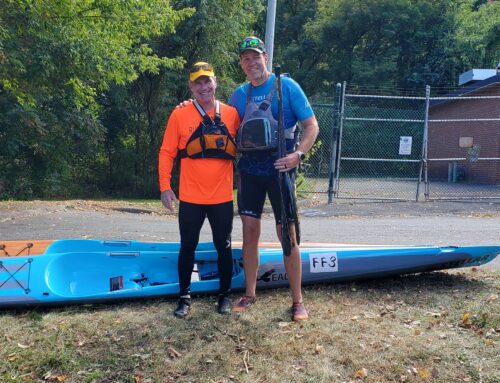
Leave A Comment
You must be logged in to post a comment.